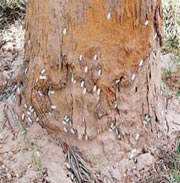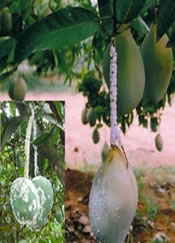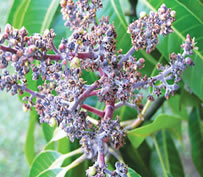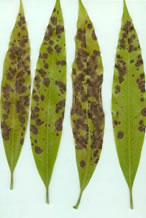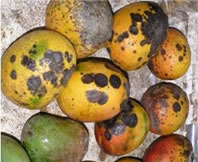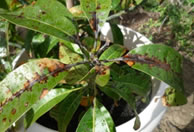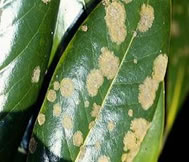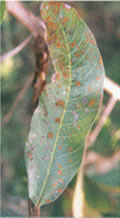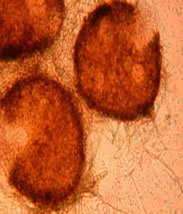
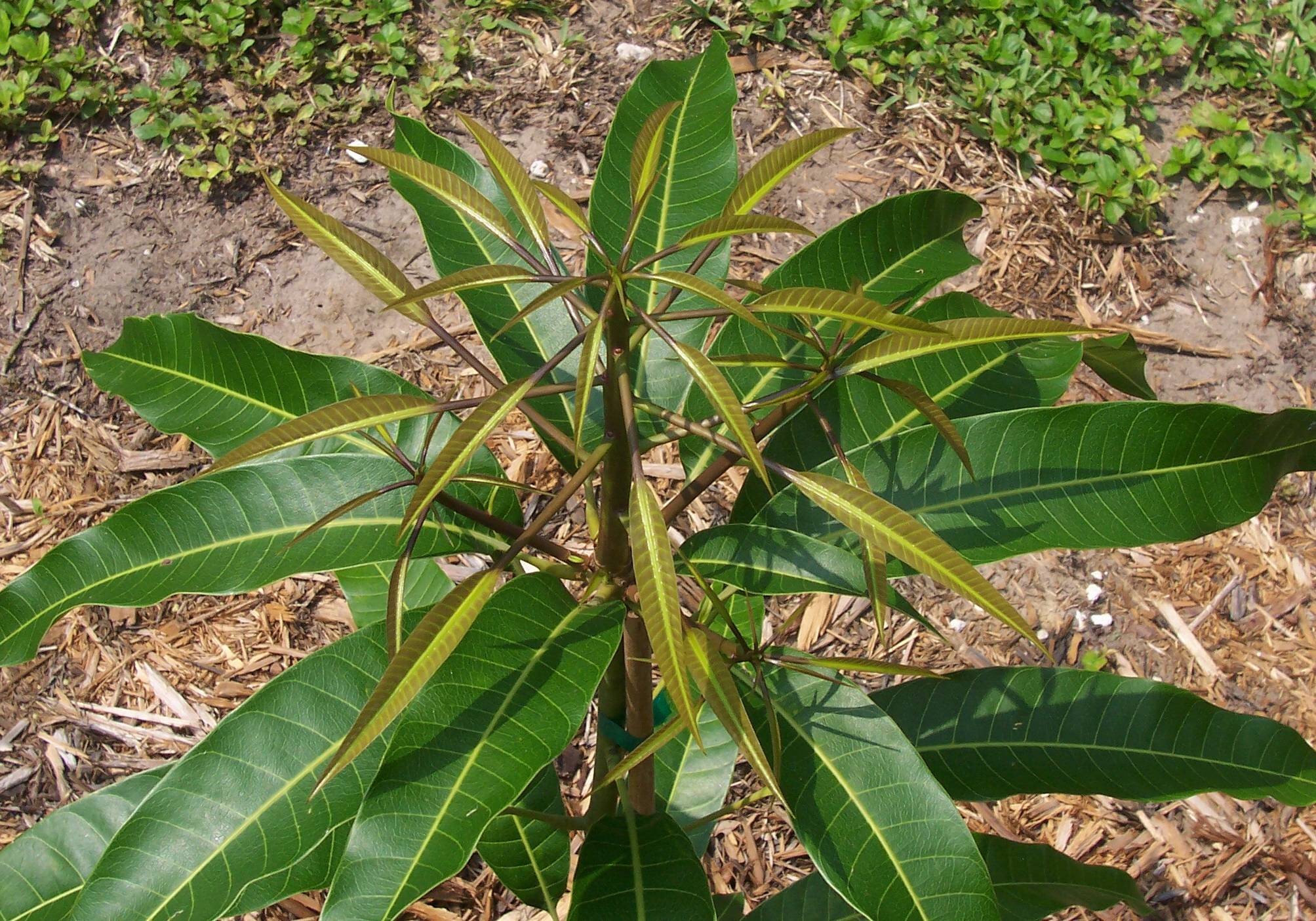 |
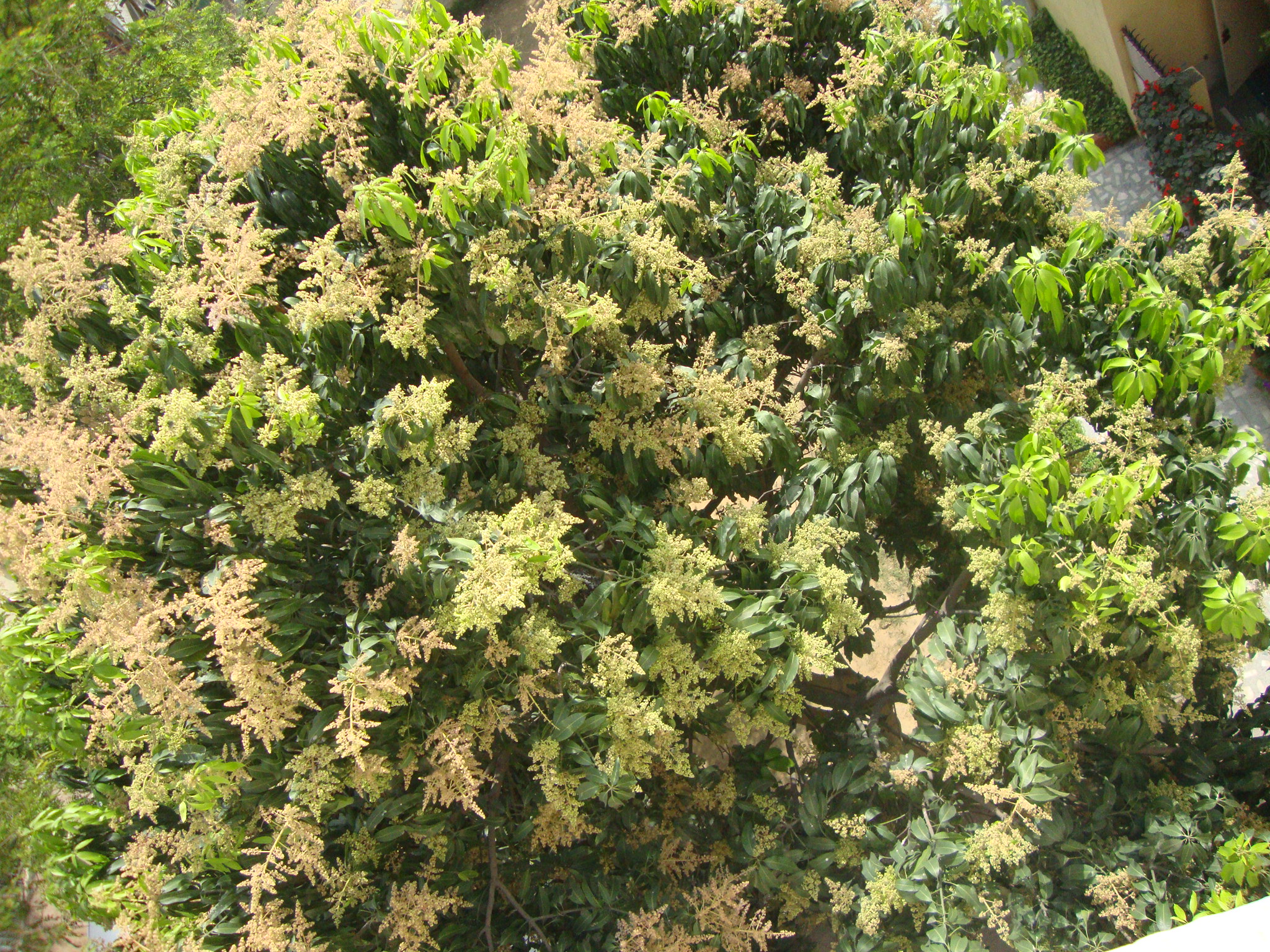 |
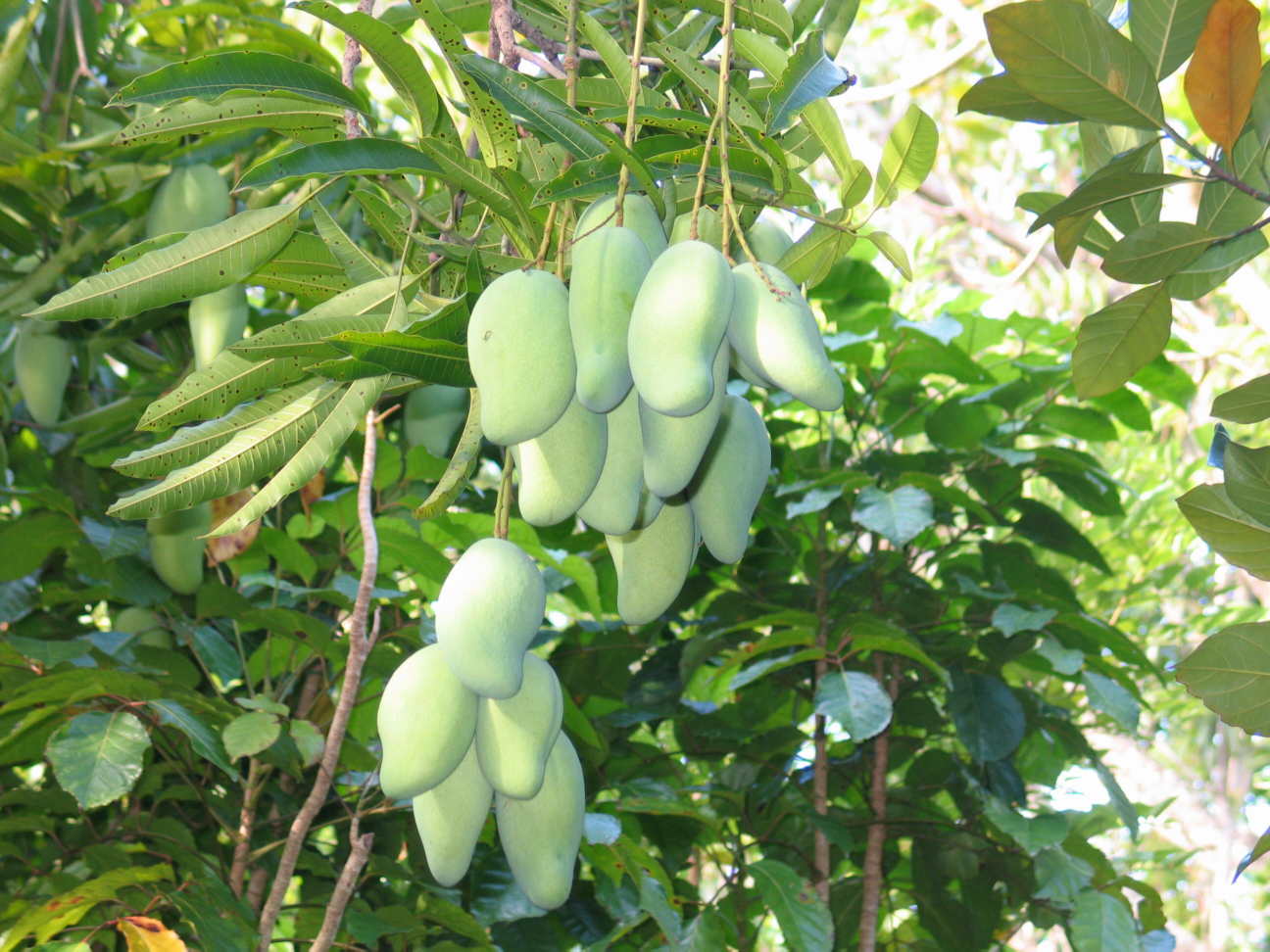 |
| Germination stage |
| Young plant growth stage |
| Parts affected | Symptoms |
Management |
Image |
| Panicles, leaves and stem | • The adult and nymphs of hoppers, suck the sap from tender parts resulting in reduction of vigour. • Heavy infestation causes curling and drying of infested parts. • Inflorescence infestation results in complete loss of crop. • The hoppers after sucking, excretes sweet sticky substance which facilitate the development of fungi, Maliola and Capnodium spp., commonly known as sooty mould which gives black look to the trees and affects photosynthetic activity. • Hoppers are present round the year in the orchard but population used to be high during February to April and June to August. |
• Pruning of dense orchards in the month of December, orchard sanitation and • 3 sprays of Carbaryl (0.02%) or Propanophos (0.05%) or Imidachlopid (0.005%) at early stage of panicle formation if, population exceeds from 10 hoppers per panicle. • The second spray should be given at full length of panicle but prior to full bloom and third at pea stage of fruits. • Nymph predators Mallada boninensis and Chrysopa lacciperda and egg parasite Polynema sp., Gonatocerus sp. and Tetrastichus sp. are found effective in nature against the hoppers. • A fungus, Verticillium lacani has also been found effective against this pest but under moderate climate. Spraying of Nimbicidine (0.2 %) is effective at initial stage of hoppers management. |
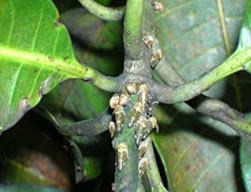 |
| Affected shoot and panicle | |||
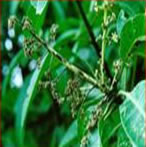 |
| Parts affected | Symptoms |
Management |
Image |
|
| Whole plant | • Adults and nymphs both sucks the plant sap and reduce the plant growth, destroy inflorescence and causes fruit drop. • Mealy bug excretes honey dew, a sticky substance, which facilitates the development of sooty mould fungi ( Maliola mangiferae & Capnodium mangiferae ). • The female insect crawls down in the month of April/May to lay the eggs in soil. • The eggs hatch in the following month of November/December and crawls up the tree. |
• Flooding the orchard in the month of October and deep ploughing in November, • Fastening of alkathene 25 cm wide sheet (400 gauge) afterwards mud plastering of trunk at 30 cm above the ground in the middle of December. • Loosening of soil around the tree trunk and mixing of Chlorpyriphos dust (1.5%) @ 250 g per tree helps in reduction of mealy bug population. • This dust can also be applied below the alkathene band on tree trunk and soil. • Spraying of Propanophos (0.05%) or Imidachlopid (0.005%) for control of nymphs already made the way up to tree. • The integrated approach (IPM) of above has been found effective in management of mealy bug but spraying of neem products along with soil application of Beauveria bassiana spores will be further useful in population reduction of this pest. • Apart from B. bassiana , coccinellid beetles (predator), Minochillus sexmaculatus , Rodolia fumida and Suminus renardi are natural bio-control agents of this pest. |
Mealy bugs found on base of the tree, inflorescence and fruits |
|
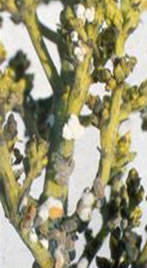 |
|
|||
| Parts affected | Symptoms |
Management |
Image |
| Young Shoot | • Larvae of this insect bore in to the young shoot which results in its drying. • The infestation of larvae has also been noticed on inflorescence stalk. • Eggs are laid in tender leaves and after hatching larvae enter in mid rib and afterwards in growing shoot from tip downwards. • There are four overlapping generation of this pest in a year. |
• Clipping and destruction of infested shoots and • spraying (2-3) of Carbaryl (0.2%) or Propanophos (0.05%) or Imidachlopid (0.005%) at fortnightly intervals. |
 |
| Parts affected | Symptoms |
Management |
Image |
| Leaves and petiole | Affects leaves, petioles, twigs, blossoms and fruits. • It is one of the important post-harvest diseases of mango. • The disease produces leaf spot, blossom blight, withertip, twig blight and fruit rot symptoms. • Tender shoots and foliage are easily affected which ultimately cause ‘die back’ of young branches. • Older twigs may also be infected through wounds which in severe cases may be fatal. |
• Remove diseased parts and destroy them by burning. • Foliar infection: 2 sprays of Copper oxychliride (0.3%), while latent infection of the pathogen on fruits could be reduced by pre-harvest sprays of Thiophanate methyl or Carbendazim (0.1%). • Post-harvest infection: Post-harvest dip of fruits either with hot water alone (45 ± 20°C ) or hot water in combination of fungicides, Thiophanate methyl or Carbendazim (0.05%). • Covering of fruits on tree, 15-days prior to harvest with news or brown paper bags and use of bio-control organism, Streptisporangium pseudovulgare . |
|
| Parts affected | Symptoms |
Management |
Image |
| Leaves, inflorescence and young fruits | White superficial powdery fungal growth on leaves, stalks of panicles, flowers and young fruits. • Affected flowers and fruits drop pre-maturely reducing the crop load considerably or might even preven the fruit set. • Rains or mists accompanied by cooler nights during flowering are congenial for the disease spread. • The fungus parasitizes young tissues of all parts of the inflorescence, leaves and fruits. |
Pruning of diseased leaves and malformed panicles • Three sprays of fungicides at different stages starting with Wettable Sulphur (0.2%) at the panicle size of 7.50 -10.00 cm followed by Dinocap (0.1%) after 15-20 days of first spray and Tridemorph (0.1%) after15-20 days of second spray. • Wettable Sulphur (0.2%) can be used in all the three sprays and number of sprays may be reduced as per appearance time of disease. |
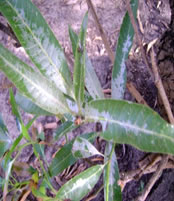 |
| Parts affected | Symptoms |
Management |
Image |
| Seedling and young plants | • The affected plants develop swollen abnormal vegetative growth with short internodes. • Leaves are small, narrow and often produced on the top of seedlings in clusters, giving it a bunchy appearance. |
• Remove malformed panicles and its destruction, • Remove of late December and early January flowers and • Application of NAA (200 ppm) in the first week of October. |
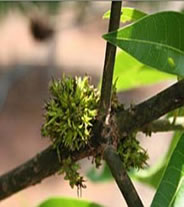 |
| Parts affected | Symptoms |
Management |
Image |
| Leaves | •yellow undersized leaves
|
• Application of recommended nitrogenous fertilizers (69kg of Urea/acre) or foliar application of Urea 20gm-40gm/lit water at fortnightly intervals. |  |
| Parts affected | Symptoms |
Management |
Image |
| Leaves | • retarded growth |
• Soil application of single super phosphate or foliar application of ortho phosphoric acid 5ml/lit thrice. | 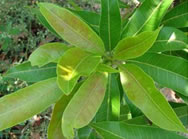 |
| Parts affected | Symptoms |
Management |
Image |
| Leaves and Roots | •darkening of leaves |
• Foliar spray of KCl 20ml/lit at fortnightly intervals. | 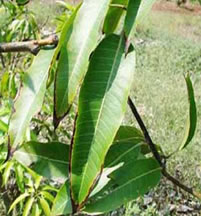 |
| Parts affected | Symptoms |
Management |
Image |
| Leaves and buds | • Abnormal growth of young leaves and growing points resembling boron deficiency |
• Application of gypsum at 50 kg/ha. | 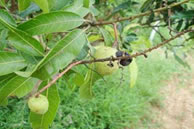 |
| Parts affected | Symptoms |
Management |
Image |
| Leaves | •reduction in growth |
• Soil application of MgSO4 5-10 kg/ha a foliar spray of MgSO4 20ml/lit at fortnightly intervals. | 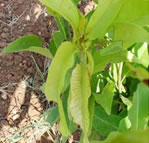 |
| Parts affected | Symptoms |
Management |
Image |
| Leaves | • symptoms first appear on young leaves with fading of green colour |
• Soil application of sulphur fertilizer | 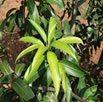 |
| Parts affected | Symptoms |
Management |
Image |
| Fruits | •deficiency is common in high rain fall areas, high temperature, soil acidity and calcareous soils |
• Application of 5-10 kg Borax / ha or foliar spray of 2.5ml/lit Borax at 10 days interval or solubor at 300 gm/ 100litres of water | 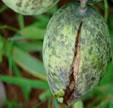 |
| Parts affected | Symptoms |
Management |
Image |
| Leaves | •shoots produced on long drooping S-shaped branches of previous growth are weak lose foliage and die back |
• Foliar spray of Copper oxy chloride 2ml/lit at fortnightly intervals | 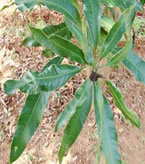 |
| Parts affected | Symptoms |
Management |
Image |
| Leaves | •symptoms are first seen in the youngest leaves |
• Soil application of FeSO4 fertilizer | 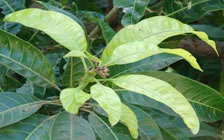 |
| Parts affected | Symptoms |
Management |
Image |
| Leaves | •deficiency appears on the middle of the plant |
• Foliar application of MnSO4 2ml/lit at fortnightly intervals | 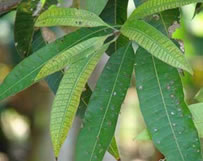 |
| Parts affected | Symptoms |
Management |
Image |
| Leaves | •leaf blade thickens, leaf shape is distorted |
• Soil application of ZnSO4 10 kg/ha or foliar spray of ZnSO4 5ml/lit or nitrozinc at 150 ml /100litres of water. |
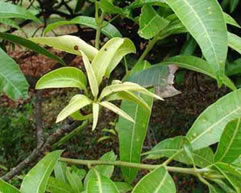 |
| Tree growth stage |
| Parts affected | Symptoms |
Management |
Image |
| Panicles, leaves and stem | • The adult and nymphs of hoppers, suck the sap from tender parts resulting in reduction of vigour. • Heavy infestation causes curling and drying of infested parts. • Inflorescence infestation results in complete loss of crop. • The hoppers after sucking, excretes sweet sticky substance which facilitate the development of fungi, Maliola and Capnodium spp., commonly known as sooty mould which gives black look to the trees and affects photosynthetic activity. • Hoppers are present round the year in the orchard but population used to be high during February to April and June to August. |
• Pruning of dense orchards in the month of December, orchard sanitation and • 3 sprays of Carbaryl (0.02%) or Propanophos (0.05%) or Imidachlopid (0.005%) at early stage of panicle formation if, population exceeds from 10 hoppers per panicle. • The second spray should be given at full length of panicle but prior to full bloom and third at pea stage of fruits. • Nymph predators Mallada boninensis and Chrysopa lacciperda and egg parasite Polynema sp., Gonatocerus sp. and Tetrastichus sp. are found effective in nature against the hoppers. • A fungus, Verticillium lacani has also been found effective against this pest but under moderate climate. Spraying of Nimbicidine (0.2 %) is effective at initial stage of hoppers management. |
 |
| Affected shoot and panicle | |||
 |
| Parts affected | Symptoms |
Management |
Image |
|
| Whole plant | • Adults and nymphs both sucks the plant sap and reduce the plant growth, destroy inflorescence and causes fruit drop. • Mealy bug excretes honey dew, a sticky substance, which facilitates the development of sooty mould fungi ( Maliola mangiferae & Capnodium mangiferae ). • The female insect crawls down in the month of April/May to lay the eggs in soil. • The eggs hatch in the following month of November/December and crawls up the tree. |
• Flooding the orchard in the month of October and deep ploughing in November, • Fastening of alkathene 25 cm wide sheet (400 gauge) afterwards mud plastering of trunk at 30 cm above the ground in the middle of December. • Loosening of soil around the tree trunk and mixing of Chlorpyriphos dust (1.5%) @ 250 g per tree helps in reduction of mealy bug population. • This dust can also be applied below the alkathene band on tree trunk and soil. • Spraying of Propanophos (0.05%) or Imidachlopid (0.005%) for control of nymphs already made the way up to tree. • The integrated approach (IPM) of above has been found effective in management of mealy bug but spraying of neem products along with soil application of Beauveria bassiana spores will be further useful in population reduction of this pest. • Apart from B. bassiana , coccinellid beetles (predator), Minochillus sexmaculatus , Rodolia fumida and Suminus renardi are natural bio-control agents of this pest. |
Mealy bugs found on base of the tree, inflorescence and fruits |
|
 |
|
|||
| Parts affected | Symptoms |
Management |
Image |
| Tender shoots and leaves | • Infestation starts from the month of April and continues up to December. • Eggs are laid singly or in clusters in the webs on leaves. • After hatching, the caterpillar feeds on leaf surface and make web of tender shoots and leaves together and feeds inside. • Pupation also takes place inside the web but last generation (December-January) pupates in soil. |
• Pruning and destruction of infested shoots during April to May. • ploughing of orchards and loosening of soil around the trees in January, and • Spraying (2-3) with Carbaryl (0.2%) or Propanophos (0.05%) or Imidaclopid (0.005%) at 15-days interval reduces the population of this pest. |
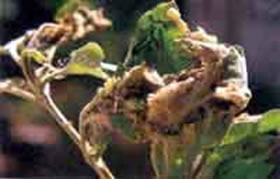 |
| Parts affected | Symptoms |
Management |
Image |
| Bark of stem | • Larvae of this pest feed on the tree bark and spin brown silken web which consist of its excreta and wood pieces and make tunnels in the stem and branches. • Larvae generally feed from April to December and have only one generation in a year. |
• Keep the orchard clean. • Remove webs from tree trunks. • Fill the insect holes with emulsion of Monocrotophos (0.05%) or DVVP (0.05%) and plugging with mud. |
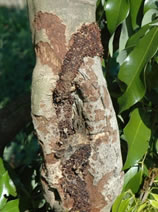 |
| Parts affected | Symptoms |
Management |
Image |
| Stem | • The grub feeds inside the stem, making tunnel upward which results in drying of branches and in severe cases death of tree. • Eggs are laid either in the cracks of tree trunk or in the cavities of main branches which covered with viscous fluid. • Grub pupates inside the stem and beetle emerges in July/August. |
• Maintain the orchard clean • Apply propanophos (0.05%) or Imidaclopid (0.005%) or DDVP (0.05%) in hole of insect and plugging with mud. |
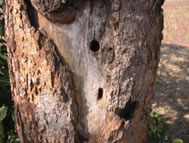 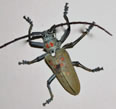 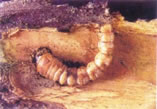 |
| Parts affected | Symptoms |
Management |
Image |
| Young Shoot | • Larvae of this insect bore in to the young shoot which results in its drying. • The infestation of larvae has also been noticed on inflorescence stalk. • Eggs are laid in tender leaves and after hatching larvae enter in mid rib and afterwards in growing shoot from tip downwards. • There are four overlapping generation of this pest in a year. |
• Clipping and destruction of infested shoots and • spraying (2-3) of Carbaryl (0.2%) or Propanophos (0.05%) or Imidachlopid (0.005%) at fortnightly intervals. |
 |
| Parts affected | Symptoms |
Management |
Image |
| Leaves, petioles, twigs, branches and fruits. | • Angular to irregular lesions on leaves, dark brown to black, cankerous on lower side but occasionally on both the sides and surrounded by chlorotic halo. • Cankers on petioles are raised and dark brown to black in colour, while on twigs and branches are raised with longitudinal fissures. • Lesions on fruits are raised and dark brown to black which gradually develop in to cankers. • Under favourable condition lesions increase in size and sometimes cover complete fruit. • Lesions often burst extruding gummy substances containing bacterial cells of the pathogen. • Fruits may drop off, if infection comes at stem end. |
• Regular inspection of orchards and its sanitation • Use of healthy stones for root stock, • 3 sprayings of Streptocycline (200ppm) or Copper oxychloride (0.3%) alone or its combination and • Use of bio-control agents, Bacillus coagulans , B. amyloliquifaciens , B. subtilis and fluorescent pseudomonads. |
|
| Tree maturity stage |
| Parts affected | Symptoms |
Management |
Image |
| Panicles, leaves and stem | • The adult and nymphs of hoppers, suck the sap from tender parts resulting in reduction of vigour. • Heavy infestation causes curling and drying of infested parts. • Inflorescence infestation results in complete loss of crop. • The hoppers after sucking, excretes sweet sticky substance which facilitate the development of fungi, Maliola and Capnodium spp., commonly known as sooty mould which gives black look to the trees and affects photosynthetic activity. • Hoppers are present round the year in the orchard but population used to be high during February to April and June to August. |
• Pruning of dense orchards in the month of December, orchard sanitation and • 3 sprays of Carbaryl (0.02%) or Propanophos (0.05%) or Imidachlopid (0.005%) at early stage of panicle formation if, population exceeds from 10 hoppers per panicle. • The second spray should be given at full length of panicle but prior to full bloom and third at pea stage of fruits. • Nymph predators Mallada boninensis and Chrysopa lacciperda and egg parasite Polynema sp., Gonatocerus sp. and Tetrastichus sp. are found effective in nature against the hoppers. • A fungus, Verticillium lacani has also been found effective against this pest but under moderate climate. Spraying of Nimbicidine (0.2 %) is effective at initial stage of hoppers management. |
 |
| Affected shoot and panicle | |||
 |
| Parts affected | Symptoms |
Management |
Image |
|
| Whole plant | • Adults and nymphs both sucks the plant sap and reduce the plant growth, destroy inflorescence and causes fruit drop. • Mealy bug excretes honey dew, a sticky substance, which facilitates the development of sooty mould fungi ( Maliola mangiferae & Capnodium mangiferae ). • The female insect crawls down in the month of April/May to lay the eggs in soil. • The eggs hatch in the following month of November/December and crawls up the tree. |
• Flooding the orchard in the month of October and deep ploughing in November, • Fastening of alkathene 25 cm wide sheet (400 gauge) afterwards mud plastering of trunk at 30 cm above the ground in the middle of December. • Loosening of soil around the tree trunk and mixing of Chlorpyriphos dust (1.5%) @ 250 g per tree helps in reduction of mealy bug population. • This dust can also be applied below the alkathene band on tree trunk and soil. • Spraying of Propanophos (0.05%) or Imidachlopid (0.005%) for control of nymphs already made the way up to tree. • The integrated approach (IPM) of above has been found effective in management of mealy bug but spraying of neem products along with soil application of Beauveria bassiana spores will be further useful in population reduction of this pest. • Apart from B. bassiana , coccinellid beetles (predator), Minochillus sexmaculatus , Rodolia fumida and Suminus renardi are natural bio-control agents of this pest. |
Mealy bugs found on base of the tree, inflorescence and fruits |
|
 |
|
|||
| Parts affected | Symptoms |
Management |
Image |
| Leaves, petioles and twigs. | • Initially the spots are greenish grey and velvety in texture which finally turn to reddish brown. • After shedding the spore the algal matrix remains attached to leaf surface, leaving a creamy white mark at the original rust spot. |
• Supply of balanced nutrients to the plants and • Two sprays of Bordeaux mixture (1%) or Copper oxychloride (0.3%) in the month of July at 15 days interval. |
|
| Parts affected | Symptoms |
Management |
Image |
| Leaves, petioles, twigs, branches and fruits. | • Starts as minute, irregular, yellow to light brown scattered spots on allover the leaf lamina. • Fullly developed spots are dark brown margin and dull necrotic grey centers. • In severe cases spots coalesce and form big patches resulting in withering and defoliation of infected leaves. |
• Application of balanced nutrients to the plants. • Spraying of Copper oxychloride (0.3%) |
|
![]()
Focus Districts
Gallery
